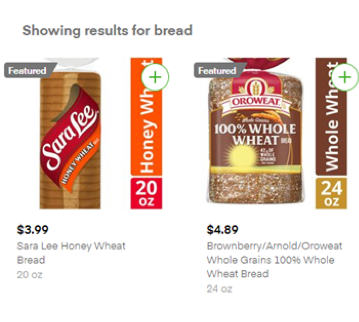It used to be a sure bet that when it came to digital advertising, Facebook was THE big enchilada, with 2b users and a perfected self-service ad platform, you could reach virtually anyone for less than a $1. But could the tide finally be turning? The lack of trust by brands on Facebook culminated with the blackout in June 2020. In addition Facebook will see in the future challenges coming from restricted tracking for iOS users.
What now? The plan for brands should be diversification, and DTC (direct to consumer) brands are seeing new platforms and possibilities pop up. On-line shopping took off in a big way in 2020 and Instacart, the online grocery delivery service, was perfectly positioned to take advantage of this. Its ad platform was launched in May 2020 and offers a self-service platform where brands promote their products through its flagship service - personalized search results with ‘Featured Products’. But let’s shout this out “ INSTACART IS NOT FOR GROCERIES ONLY ANYMORE” retailers like Sephora, Walgreens, Rite-Aid, Buy Buy Baby, Bed Bath and Beyond, Petco, CVS and Best Buy are also available on Instacart now.
Each customer makes on average 20 searches per order and more than half of all cart additions come from search, making it the perfect keyword search ad opportunity. Other ad opportunities on Instacart come in the form of marketplace banners, coupons and delivery promotions.
Outlined below are what we feel are some of the pro and cons of including Instacart ads in your digital strategy:
Instacart Insight
Pros
Sales Growth. You are reaching shoppers when they are most ready to buy groceries, if your campaign objective is sales, then you are perfectly positioned to capture a willing audience
Lower CPCs. Instacart users have high conversion rates and high average order values, both of which helps brands to achieve lower CPCs
Repeat purchases. Think preloaded shopping lists
Scale. This one platform can promote your product across 300 retailers, including Costco and Target
Pay for Performance. No min budget and a cost per click model
Lack of competition. It’s still early so the space is not yet saturated, another reasons why current users experience low CPC’s
It’s self-service. You’ll be using easy to follow dashboards where you create and manage your campaigns instantly. Checking on your ROAS is a breeze
Unique insight. Collecting data on shopping and purchase behavior along with preferences relative to products is a key asset on Instacart e.g. what products are favored by location or products most likely to be purchased together
Cons
Pay for Upgrades. The more you spend on advertising the more data you get, regardless of the size of your company, so if you want the juicy data, expect to pay more for it
Growing pains. Instacart ad service teams are still navigating best practices and we’ve experienced some contradictory advice
Not yet fully self-service. Coupons, delivery promotions and banners have to be booked directly with Instacart
Advertising limited to your inventory distribution e.g. if you’re only in 10 stores you can only advertise based on those search terms in specific locations
Instacart is here to stay and it is clear that is fast becoming a game-changing advertising platforms for brands. We’re not saying it’s taking over from Facebook but if you’re a DTC business you’ll want to consider this option now before it becomes oversaturated.
If you’d like to learn more about advertising opportunities on Instacart or other digital ad retailer platforms contact us.



